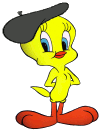
Rhone-Alps
Lyon, "the capital of Gauls"![[Unesco]](/images/unesco-logo.gif)
Lyon (my hometown) is located between Rhone and Saone.
To fully enjoy the city, you can visit it in August when traffic is low. Otherwise, it is quite difficult to drive in Lyon because of traffic jam, lots of one-way streets and sometimes lack of patience among drivers. However, one can go by foot or bike (velo'v are bikes one can rent with a credit card).
Below, one of the lions of the temporary exhibition (June-September 2004) kept at the house of the notaries near St. John, and the emblem of Lyon on one of the facades of the school La Martinière near Terreaux square.
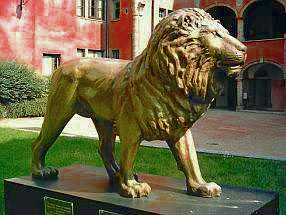
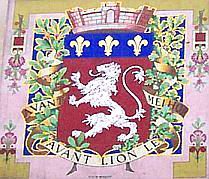
A date to visit Lyon is December 8 for illuminations : at dusk, the balconies are adorned with candles and since a few years light shows are held on the main city squares. This light festival is a tribute to the Virgin who saved the city from the plague in 1643. She was celebrated on September 8, the anniversary of her birth but in 1852, while one wanted to couple this celebration with the unveiling of her statue (made of gilded bronze) to the basilica of Fourviere, the overflow of the Saone forced to postpone the date. It was finally achieved on December 8, the date of the celebration of the Immaculate Conception, but the rain fell all day and only stopped at night fall. Then candles were first lit at a few windows and finally in a burst of religious fervor, at all the windows. The tradition has been perpetuated each year.
Lyon is also the former Gallo-Roman capital from which some vestiges remain (see § amphitheaters), a city of silk and food with specialities such as dumplings and sausages (rosette, jesus...), a large variety of offals, gratons (fried and salted pork fat), Lyonnaise salad (with bacon and poached eggs), cardoon (which is an herb), bugnes (the local pastry), and various kind of chocolate (called coussins, cocons, quenelles, bouchons...) made by the famous chocolatier of Lyon "Voisin". The best places to buy typical food Lyon are the old city and the "halles" in the third district. The cheese from Lyon (with contains garlic) is called "cervelle de canuts" which means "brains of canuts (a canut was a silk weaver)"... Traditional restaurants of the old Lyon are called "bouchons". They may still serve "mâchon" in the morning. The mâchon, a word from Lyon (other French people will probably not understand), was the former "breakfast" of silk workers who had to get up early in the morning and met together after a few hours of work to have pork meat and Beaujolais red wine. Indeed, Beaujolais wine is very popular and it has often been said that there were three rivers flowing in Lyon : the Rhone, the Saone and the Beaujolais...
Bellecour square
Located on the peninsula (the part between the Rhone and the Saone), Bellecour square is the largest pedestrian square in Europe. There is the tourist office in a corner near the tower of charity, a tower that was part of a former hospital built in the 16th century with the "General Alms". In the center, there is an equestrian statue of Louis XIV (the city remained faithful to the young king during a revolt). It was made of bronze in 1823 by architect Lemot from Lyon to replace the one that had been destroyed during the French Revolution. Lyon indeed rebelled shortly after the revolution of 1789, in 1793 against the excesses of the Convention (government of the Republicans) and was besieged and bombarded by the Republican troops before surrendering.
At one corner of the square there is a statue of Saint-Exupery (born in Lyon) and his main character "the little prince". On the opposite side there is a great wheel.
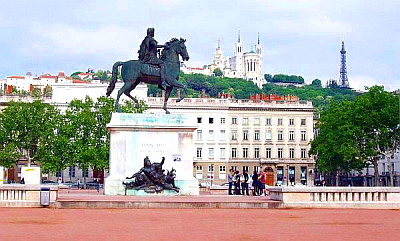
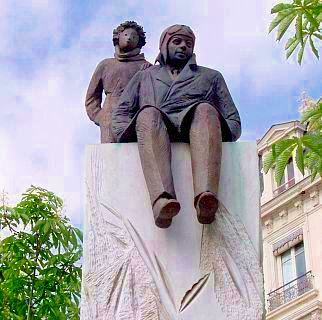
Colloquially called Saint Ex, the count Antoine Marie Jean-Baptiste Roger de Saint Exupéry was born in Lyon in 1900. He joined Aéropostale in 1926 (which was then the company Latécoère) and was thus one of the pioneers of international postal flight with Jean Mermoz and Henri Guillaumet. His first novel, Courrier Sud, in which he describes his life as an aviator was written in 1929. On 31 December 1935, he was forced to land in Libyan desert in Egypt while attempting to beat the record for crossing Paris-Saigon. He wandered for four days in the wilderness before being rescued. In 1939 he published the novel Terre des Hommes (Man and His World), an autobiographical work in which he shared his thoughts with a quest for meaning. He quotes Henry Guillaumet who had himself survived miraculously thanks to his iron will to a crash in the Andes : "I swear that what I went through, no animal would have gone through". The novel was awarded the Grand Prix of the French Academy novel.
He was mobilized in 1939 at the beginning of World War II and joined the United States after the armistice between Germany and France. In 1943, while he was leaving in New York, he published The Little Prince in which he drew himself the illustrations. He resumed service in 1943 for missions from North Africa. He disappeared on the 31st July 1944 during a reconnaissance mission to prepare the Allied landing in Provence.
The two longest pedestrian streets of the city lead to the square from opposite directions. The longest is the street of the Republic (where one finds Fnac and cinemas) that ends near Terreaux square, and the other one is Victor Hugo street (with many shops) that takes the direction of Perrache station through old neighborhoods such as Ainay where there are shops for collectors (philatelists, numismatists).
Terreaux square
The second landmark of Lyon is without doubt Terreaux square that has unfortunately lost some of its charm since a few decades ago... It is a rendez-vous place with bars and cafes.
To be seen : the great fountain which was carved by Bartholdi (the sculptor of statue of Liberty and the Lion of Belfort) for the Universal Exhibition in Paris. It is called "the chariot of freedom" or "the Garonne River and its tributaries" depending on the allegory we attribute to it (as far as I am concerned I prefer the first one because the Garonne runs rather far from Lyon !... although the statue was first meant for the city of Bordeaux, which had not purchased it). Look at the nostrils of the right horse : steam comes out from it...
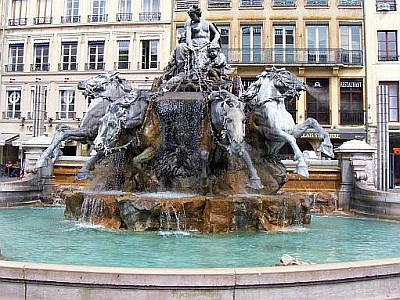
The city hall, surmounted by a belfry, was the largest municipal building in the middle of the 17th century. In the courtyard, one of the statues represents the cyclops Polyphemus (the one that Ulysses had to fight)... with three eyes. The sculptor has indeed probably first made the statue without knowing that Polyphemus was a Cyclops and he then added an eye in the forehead.
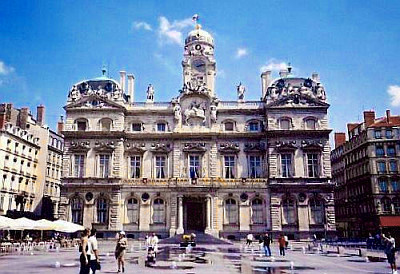
The modern opera (we like it or not...) is located behind the City Hall.
In front of the fountain stands the fine arts museum in St. Peter palace, a former Benedictine convent.
Rumor states that occultism was practiced near Terreaux square. Indeed, Lyon is known for occultism since antiquity : alchemists lived in Lyon, Nostradamus had acquaintances in Lyon where he had his "centuries" printed, the "magician" Cagliostro founded a lodge in Lyon, Allan Kardec (founder of spiritism) was born in Lyon, the healer master Philippe lived and practiced in Lyon (his grave in the cemetery of Loyasse is still decorated with flowers)... Lyon is also one of the capitals of Freemasonry...
Croix-rousse and old Lyon through the traboules
The name traboule comes from the Latin trans ambulare, which means : to move through. Traboules are pathways through courtyards to link two parallel streets. The entrance to a traboule looks like an entrance to any other old building : one must know where there are. Nowadays, signs and indications are displayed to find them.
There are two major networks of traboules : one from Terreaux square to Croix-Rousse -the working hill- and another in Old Lyon at the foot of Fourviere -the praying hill-.
Croix-Rousse
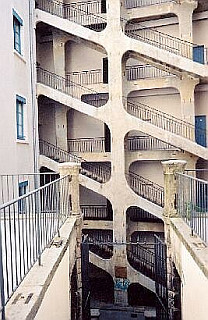
Croix-Rousse is the old district of canuts : silk weavers that poor living conditions led to revolt in the 19th century with the motto "live by working or die by fighting".
The name Croix-Rousse comes from a coloured stone cross located at a crossroads. This cross has now disappeared and the one that can be found at the end of grande rue de la Croix-Rousse is not the original one.
To access the Croix-Rousse by the traboules, you have to go to number 6 Terreaux square (if closed, start the tour from rue Sainte Catherine), then follow signs (head of a lion on a yellow background). Actually, it is better to get a map or start in the reverse order (ie from Colbert square), but roughly traboules are always in the same direction (up) and from an entrance to another one can have to walk a little along the street.
We go through several courtyards and buildings, until arriving at cour des voraces which leads to Colbert square : main square of silk weavers in the 19th century.
The statue of Jacquard, a Lyonnais inventor of the loom that bears his name, is located on the square of the Croix-Rousse. Near it, there is the "big stone" which is the symbol of the neighborhood. This is a stone dating back to the Ice Age, but a legend states that it is the heart of a bailiff who had thrown out a family without money : he was then sentenced by God to push his heart of stone until he meets someone more greedy than him...
Further on, -in Ivry Street-, the house of canuts offers to discover the traditional gestures of weavers with demonstrations on handlooms (approx. an one hour visit).
At 87 grande rue de la Croix-Rousse there is Rosa Mercader Mir garden. It is only open on Saturdays from 3 p.m to 6 p.m. and from 1 April to 30 November and is not well known even by Lyonnais themselves. Actually, there is no sign about it ! Yet it is a quick and free visit that is really worth doing !
This 400 m² (480 SqYrd) private garden was created in the 1950s from stones and shells by its owner Jules Senis, an immigrated Spanish who had worked in the Gaudi sites in Barcelona. It took no less than 25 years to reach the final result. One can not miss the parallel with the Ideal Palace of the postman Cheval in Hauterives, the chapel of Mount Cindre in the Mounts d'Or of Lyon (but which is unfortunately not open to visitors...) or also with the house Picassiette of Chartres.
A small chapel was even added in honor of his mother Rosa Mercader Mir (to whom the garden is dedicated) and the Blessed Virgin.
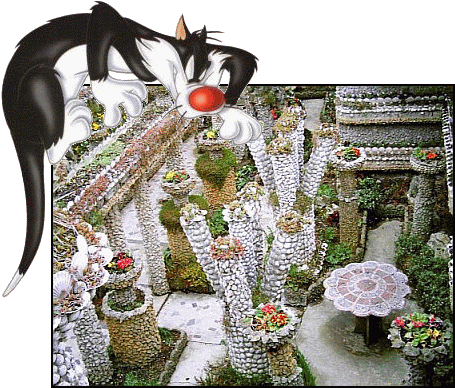
We can go down by the slopes of Croix-Rousse or making a detour to the amphitheater of the three Gauls which not much remains, but which is historic as this is the place where early Christians of Gaul (Bishop St. Pothinus, slave St. Blandine...) were martyred for their faith in 177 AD. Blandine is the patron Saint of Lyon and, also with St. Martha, the patron Saint of the servants. See St. John's cathedral.
Old Lyon
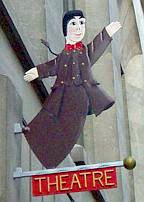
After crossing the Saone one reaches the old Lyon, which stretches from St. Paul square to St. Georges footbridge through the neighbourhood of St. John cathedral.
In these former working-class/middle-class/shopping neighborhoods the style, often hidden, is from Italian Renaissance. This style appeared in Lyon during the 16th century with the making of silk as in Italy (banks also developed in the city at that time). To appreciate this style one must enter the courtyards such as : 14 or 16 rue du Boeuf, 8 rue Juiverie and 28 rue Saint-Jean. The towers were built around outside stairs.
Gadagne museum is a two-in-one museum about the history of Lyon and puppets such as Guignol. In fact, Guignol is a puppet invented in Lyon in the early 19th century. A unemployed canut, Laurent Mourguet became dentist (or "tooth puller" as they were called at that time) and like many of his colleagues, he used a Punch to distract his patients' attention. He then got the idea to create his own puppet : Guignol, with hair tied in a ponytail, and carrying a stick. In addition to Guignol, there is also the famous Gnafron...
About puppets, we have two main types of puppets : hand puppets (with manipulation from below) and puppets with threads (with a manipulation from above). Guignol belongs to the first category. The Guignol theater is located near St. Paul square.
The Roman Church of St. Paul which dates back to the 6th century (with Gothic additions) is particular for its bell tower, its fresco of musician angels, its keystones and its acoustics.
In the old Lyon too there are traboules. We can get the one of 27 rue du boeuf (do not hesitate to press the button of the door) then we get to rue Saint-Jean (St. John street) from where we can make for place du gouvernement (government square) to take another traboule at number 2 which lead to 10 quai Romain Rolland (Romain Rolland bank). Once here we can go up by the traboule of number 17 to get to 9 rue des trois-maries and from that street we can go on with number 6 to end at 27 rue Saint-Jean.
I definitely recommand the traboule of 27 rue du boeuf and the courtyard of 2 place du gouvernement. It is not unusual to find a well in courtyard of the traboules.
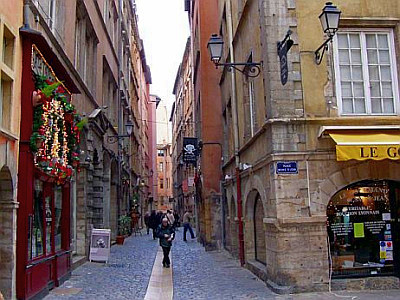
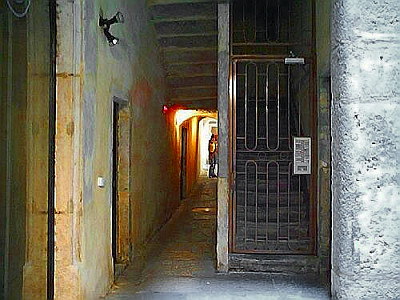
In St George neighbourhood, the church has a tympanum representing the battle of St. George against the dragon. At the beginning of rue Saint-Georges (St. George street), we can stop at the café du soleil which is the oldest café in Lyon and at the house of Guignol where puppet shows are sometimes performed in the evening. We can also visit the traboule at No. 10 (which lead to No. 12) and a automaton museum.
In the Middle Ages and until the Revolution, men of different neighborhoods got together to monitor and defend the city. They gathered under their pennons (triangular flags of their neighborhood). In April, the pennons of Lyon festival brings us to that medieval time for a weekend.
St. John's cathedral
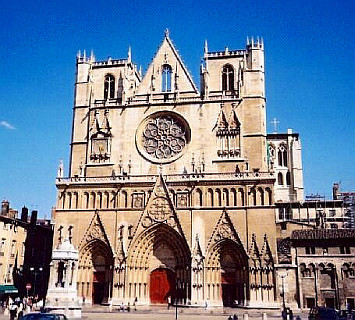
The gothic cathedral of St. John the Baptist called St. John dates back to the 12th century. It is the seat of the Archbishop of Lyon. The picture below dates back before the refurbishment of 2011 which has given a white facade to the cathedral.
A statue representing the baptism of Christ by St. John the Baptist is placed in front of the cathedral.
Outside, we can identify several animals from the medieval bestiary that decorate the gates, but most of the figures have esoteric (and alchemical) meanings rather than religious.
Inside, a panel recalls the sacrifice of the first martyrs of Roman Gaul under Marcus Aurelius in 177 AD among whom St. Pothinus (born in Phrygia), who was both the first bishop
of Lyon and the first bishop of Gaul, and St. Blandine (born in Anatolia) who was a converted slave.
Blandine is also called the mother of martyrs as given to the lions, the latter refused to attack her. She was then horribly tortured but never denied her faith.
This is St. Irenaeus (born in Smyrna, from Greek culture) who succeeded St. Pothinus and became the second bishop of Lyon.
He was opposed to the doctrine of gnosis which claimed that Salvation was achieved through esoteric knowledge
of God (only given to the elite).
He is one of the Church Fathers and succeeded in converting most of the population of Lyon. He would be the first to have designated the four canonical gospels
(as opposed to the apocryphal gospels, which are not recognized by the Church) and it would be him who would have created tetramorph to represent the four evangelists
indicating that John was the apostle of Christ and that Luke was a disciple of St. Paul. St. Irenaeus would have died martyred in Lyon in 202.
A church and a neighborhood are named after him (note : stone sarcophagi dating from about the 5th century are kept in the courtyard of that church).
To be seen in the cathedral : the marble pulpit, chapels, stained glass windows, and the astronomical clock of the 14th century. The characters (including a cock on the top of the clock) are animated during the ringtones at 12 a.m., 2 p.m. and 3 p.m. A different character depending on the day of the week appears in a small niche : a character symbolizing death on Monday, St. John the Baptist on Tuesday, St. Stephen on Wednesday, a character symbolizing the Eucharist on Thursday, a character symbolizing the Passion on Fridays, the Holy Virgin Mary on Saturday, and the Risen Christ on Sunday.
The winter choir, or chapel of the canons, contains the sculpture of the "hand that heals" on a keystone which location is marked on the ground by a brass star. In ancient beliefs, one could be healed by going below it following a ritual (all this seems quite superstitious). This chapel is now generally closed to the public...
Fourviere basilica
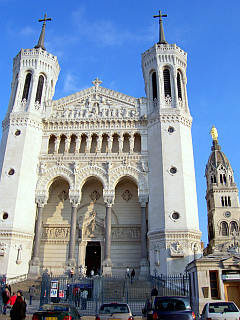
From the cathedral of St. John, you can take the funicular which go up to Fourviere. It is then interesting to go down (after having seen the roman theaters !) by the snaking path of the Rosary that leads to St. Bartholomew uphill.
The name of Fourviere comes from the Latin "forum vetus" which meant the old Roman forum.
The beautiful basilica with crenellated towers was erected after the 1870 war by the Archbishop of Lyon to fulfill a vow made to the Virgin if the Prussians did not approach the city. It is surmounted by a statue of the Archangel Michael and its adjoining chapel is topped by a statue of the Virgin (in gilded bronze). Seen from afar, it is a symbol of Lyon.
Its Roman-Byzantine style makes it very unique. Its interior is in a Byzantine style with several mosaics showing major Christian episodes.
On the stairs, we have the statue of the lion of Judah which was the symbol of the tribe of Judah, one of the 12 tribes of Israel, and from which King David, son of Jesse, is descended. In the bestiary of the Middle Ages, the lion of Judah, mentioned in the Apocalypse, was the symbol of the resurrected Christ because Joseph was a descendant of David.
Next to the basilica, there is the park des hauteurs ("in the heights") and the metal TV tower. From the basilica, as from the TV tower, the panoramic view over the city is beautiful !
The amphitheater, the Odeon and the Gallo-Roman museum in St Just area
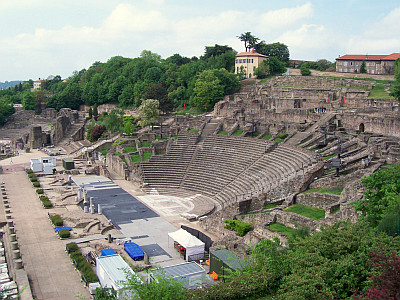
Founded in 43 B.C. by the Romans expelled from Vienna, the city has kept the remains of two Roman theaters, witnesses of its Gallo-Roman past. The ancient Lugdunum was the capital of Gauls (the three Gaules were Lugudunensis from Brittain to Lugdunum, Aquitania and Belgica. The Narbonensis was Roman). Its name meant Lug's city : Lug was the most important of the Gaulish gods. The Roman Emperor Claudius was born there in 10 B.C. In the second century, Lugdunum was the second city of the Roman Empire after Rome. The city was a great trading center via the Rhône river and was cosmopolitan. Thus Eastern and sometimes occult religions developed there, the largest of which was the cult of Cybele. The early Christians were persecuted.
The small Odeon, which could hold 3,000 people, has restored mosaics on its ground. The amphitheater could hold 10,000 people.
The access to the theaters is free, but museum admission is charged. However it is worth the visit : it is very large and contains amphorae, bronze utensils, busts, mosaics... and even a bronze registration table : the Claudius' tablet that transcribes a speech of Emperor Claudius to the Senate to authorize the eligibility of the Gauls as magistrates (thus they could become Roman citizens).
In summer, concerts are held under the name "nights of Fourviere".
frescoes
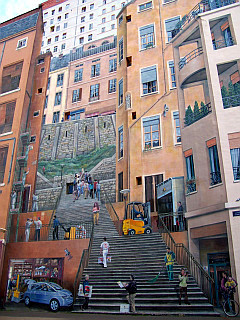
Many walls of Lyon are decorated with frescoes and trompe-l'oeil. I recommend seeing the first one at Croix-Rousse (subway station Henon) "the house of canuts" and my favorite at St Vincent bank "Lyonnais' fresco" which represents famous Lyonnais (see it in the gallery).
Outside the inner city, we can also see Tony Garnier urban museum. This open-air museum is a series of 25 wall paintings on social housing buildings located around the Etats-Unis boulevard mainly after the crossing at Paul Cazeneuve street. The common theme of this wall paintings is the ideal city. There are frescoes representing the Tower of Babel at the junction between Etats-Unis boulevard and Berthelot avenue.
At Villeurbanne there is another fresco on the Charpennes theatre wall (street Gabriel-Péri).
The painted walls in Lyon are made by the "Cité de la Création", a company from Lyon that paints walls in many places in the world. It is a good job !
Tony Garnier is an architect born in Lyon district of Croix-Rousse in 1869. He died in 1948 in Roquefort-la-Bedoul but his body was repatriated to the cemetery of Croix-Rousse in 1949. Its architecture is oriented around the concept of the "cité industrielle" or industrial city (title of his work published in 1917), a kind of ideal and modern city in which the urban functions (work, housing, health, leisure...) would be separated while space, greenery (with garden cities), and sunshine would be promoted. The materials of its achievements are reinforced concrete and glass.
This concept, classified as urban utopias of the 19th century, will influence the town planning of the Soviet Union in particular. The Greek root of the word utopia, or-topos, means "place of happiness". The name given to the concept of Tony Garnier is not unrelated to the work Utopia written in the 16th century by Thomas More and in which the latter described an ideal city.
Here are some achievements of Tony Garnier in Lyon : the Etats-Unis district between Lyon and Venissieux; the halle Tony Garnier, former slaughterhouse turned into a concert hall after 1988; the Gerland stadium; the hospital Edouard Herriot (formerly called Grange-Blanche)...
Tête d'or (golden head) park
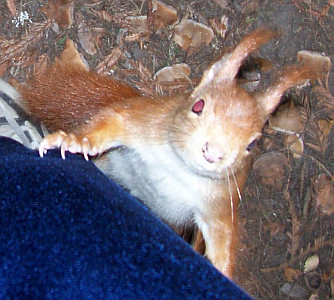
On the other side of the Rhone, the largest urban park in France (3.8 km -2.4 miles- for the periphery) is laid out as an English park. The park's name comes from a legend which indicated that a Christ's golden head had been buried there. Researches were undertaken but nothing had been found...
It is an ideal place to run or stroll along the lake, island of remembrance, the rose garden, or the zoo (with giraffes, elephants, lions, tigers, deers, goats, monkeys, lemurs...) and the botanical garden. And the good news is it is totally free !
We can also see many squirrels, some of them are really not shy ! One of them, in search of a peanut or nut, had even started my climbing ! incredible for an animal usually so careful...
Near the main entrance, you can go to the Guimet natural history Museum.
Part-Dieu
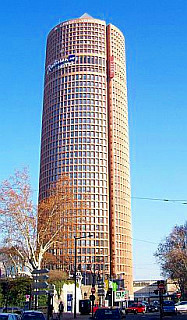
Part-Dieu is the largest district of Lyon after the peninsula (Terreaux-Bellecour-Perrache). There is the main train station of Lyon, one of the two TGV (high-speed train) stations with Perrache (excluding the station of Saint-Exupéry airport located thirty kilometers from the city). And one of the largest shopping malls of Europe is just in front of the train station.
Part-Dieu district is also the second largest business district in France after La Défense in Paris. It keeps growing with the construction of new towers such as the Oxygen tower built in 2010 (116 m) and ongoing projects including the Incity tower available in 2014 (it should reach 200 m).
But the "historic" tower is the tower of the Credit Lyonnais measuring 164 m. It is nicknamed "the pencil" and has been part of the scenery of Lyon since 1977...
St Nizier's church
The Gothic Church of St. Nizier was once devoted to the apostles Peter and Paul, and the martyrs of 177. It took the name of a bishop buried in the church in the 6th century and was source of miracles. We can note its two different spires.
Inside there are two great statues of St. Paul (with the sword) and St. Peter (with the keys). The chapel of St. Expedit, a Roman soldier, contains many ex-voto, however his real existence is not certain. St. Expedit was invoked for desperate causes.
Ainay abbey
Ainay Abbey was built in the 9th century. Nowadays, it is the oldest church in Lyon. Do not miss the frescoes of the apse where are depicted St. Blandine and St. Pothin with the palm of martyrs, the capitals and the bas-reliefs.
Other visits in Lyon
-
Other museums as those listed beside : fabrics museum, printing museum, Lumière Institute (museum that also shows early Lumiere Brothers films including the famous "watered waterer"), history center of resistance and deportation (Lyon, which was first in the "free zone" until 1942 during WWII became then the "capital of the resistance" as General De Gaulle proclaimed Lyon after liberation of the town in 1944) with also the Memorial Jean Moulin (he was a leader of the FFI - French Forces of the Interior and was arrested by the Gestapo on 21 June 1943 in Caluire) and prison Montluc.
-
The baroque church of St. Bruno, dedicated to the Saint (although never beatified or canonized) who founded the Carthusian Order. The saint is often depicted in meditation on death with the skull of the Vanities, a symbol of the fragility of human existence.
-
The facade of the Hotel-Dieu : a former hospital where I was born ;-) ).
François Rabelais was a famous French writer and humanist of the 16th century to whom we owe Pantagruel and Gargantua, but he was also a priest and a doctor. He came to practice medicine in the Hotel-Dieu and at the same time had his novels printed in Lyon. -
The facade of the old courthouse with Corinthian columns (in the 5th district) called "24 columns".
-
The banks of the Rhone.
-
The facades adorned with head statues in rue d'Algérie (number 2, 11, 20 and 21). There is a traboule via number 2.
Illuminations of 8 December
The illumination of the city on December 8 is a good opportunity of moving to Lyon. In addition to candles, "Sound and Light" shows are made on the main buildings for 3 to 4 days.
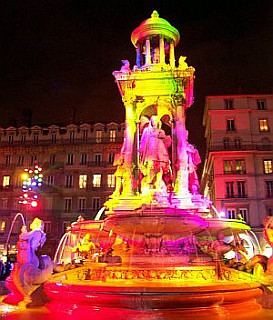
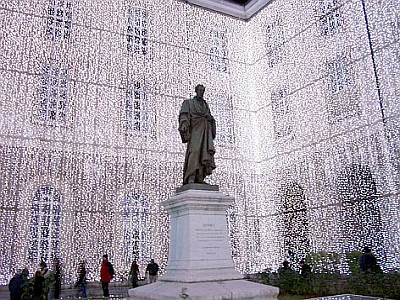
Near Lyon (<10 km)
-
The aquarium of the great Lyon is located in La Mulatière (confluence of the Rhone and the Saone). We can see a wide variety of fish such as the silure : this huge fish (up to 5 m for the largest) can be found in the Rhone...; freshwater fish (sturgeon, carp, pike); rays; sharks; groupers; turbos; globes; porcupine fish; cow fish; piranhas; moray eels; horseshoe crabs (this arthropod has blue blood); corals; sponges and sea urchins...
-
Lacroix-Laval park with its doll museum
-
Henri Malatre antique auto museum at Rochetaillé-sur-Saône.
-
The restaurant of chef Paul Bocuse, l'auberge du Pont de Collonges, is located in Collonges au Mont d'Or, his place of birth (the price is not less than 150 € per meal). More information on the site : www.bocuse.fr (choose the english flag on the bottom after entering the website).
